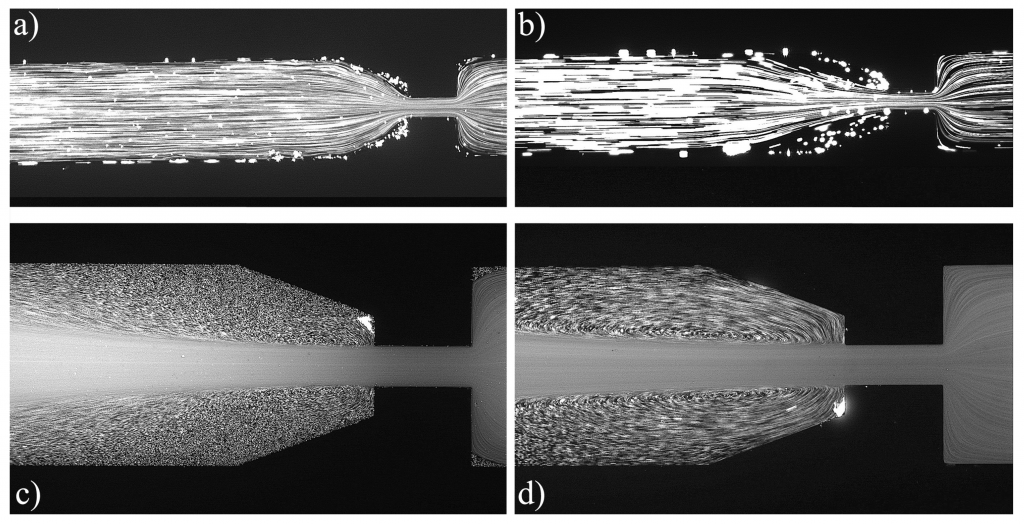In the recently published ‘Microfluidics as a Platform for the Analysis of 3D Printing Problems,’ by Rui Mendes, Paola Fanzio, Laura Campo-Deaño, and Francisco J. Galindo-Rosales, the authors explore FFF 3D printing and the inherent challenges, with a focus on extrusion flow problems and microfluidics as a way to study and solve the issues, along with other problems like misalignment, complete failure of parts, back-flow, and blockage of nozzles overall.
Printing conditions were defined regarding the Deborah number (De), the Reynolds number (Re) and the Elasticity number (El), with the cross-section of each nozzle’s structure copied in a planar microfluidic chip. The researchers constructed these replicated cross-sections with polydimethylsiloxane, and a range of fluids meant to represent a similar elasticity number to polycarbonate.
Design of the nozzle involved a variety of four different scale ratios, with each microchannel possessing an inlet and outlet port.
“Between the inlet and the outlet, there is a contraction that replicates the cross section of the 3D printing nozzle and a sudden expansion to simulate the expansion of the polymeric material when leaves the nozzle and interacts with the atmosphere,” stated the researchers.
Polydimethylsiloxane (PDMS) channels were created, crosslinked, and then the inlet and outlet ports were constructed with a stainless-steel tip mounted onto a syringe, using a precision tip with an inner diameter of 0.51 mm and an outer diameter of 0.82 mm. THE PDMS were bonded onto a microscope glass, with dimensions examined via SEM images.
“The fluid-flow was characterized by streak line photography, which consists of recording particles displacements over a period of time, allowing a qualitative analysis of the flow pattern,” stated the authors.
“To guarantee a good visualization, small concentrations of particles (40 and 90 ppm) were added to the analog fluid. Instead of using Sodium Dodecyl Sulfate (SDS) to minimize adhesion of fluorescent tracer particles (hydrophobic particles) to the channel walls, a surface treatment to the PDMS with oxygen plasma was applied to each microchannel in order to turn them hydrophilic.”
Just the process of creating the microchannels was a task, and the authors pointed out that they had to dedicate a ‘considerable amount of time’ to fabricate a mask without error. With the different scales, however, they were afforded the required flexibility for mimicking printing conditions. Three different conditions were distinguished:
- At lower Reand De, they could observe a laminar profile, with fluid attached to the microchannel walls.
- A second zone showed how the flow was detached from walls upstream of contracting
- Larger vortices caused a preferential central flow path when the Reand De were further increased
“Considering the dimensions of the vortices upstream the contraction, it is possible to conclude that they may be responsible for the back-flow problem in the 3D printer,” concluded the researchers.
“In future works, a wider range of analog fluids should be studied, not only to further complete the flow pattern map, but also to replicate the exact conditions of the printer and to discover the critical Re and De values that potentiate a laminar flow. Another approach could be creating different geometry configurations and analyze if any one of them retards or even prevents the vortex generation. Finally, using all this information, it would be possible to try to replicate numerically the extruding process inside the 3D printing in terms of flow pattern and heat transfer.”
Overall, 3D printing has made a heavy influence on microfluidics, from chip technology to a variety of different scaffolds and portable platforms. What do you think of this news? Let us know your thoughts! Join the discussion of this and other 3D printing topics at 3DPrintBoard.com.

Flow pattern for a Newtonian fluid at different values of Re. The flow direction is from left to right.

Flow pattern for PAA solutions at El∼375 and different flow conditions: (a) Point 1; (b) Point 2; (c) Point 3; and (d) Point 4 (Table 13). The flow direction is from left to right.
Subscribe to Our Email Newsletter
Stay up-to-date on all the latest news from the 3D printing industry and receive information and offers from third party vendors.
You May Also Like
New Report: Semiconductor Industry to See $1.4B in 3D Printing Revenues by 2032
“The semiconductor sector has become the most strategically significant area of global industry.” Truer words are hard to come by when it comes to the modern world, and they are...
Will Photonic-Crystal Lasers Revolutionize 3D Printing?
Powder bed fusion (PBF) for metals and polymers predominantly utilizes lasers as the primary heat source. Some directed energy deposition (DED) technologies also employ lasers, while various vat polymerization methods...
3D Printing Unpeeled: Orbex Investment, IndoMIM and HP, Ultrasonic Waves
INDO-MIM has bought three HP Metal Jet S100 printers, operating two in India and one in Texas. This is a win for HP because the company has deep experience in...
3D Printing Webinar and Event Roundup: April 21, 2024
It’s another busy week of webinars and events, starting with Hannover Messe in Germany and continuing with Metalcasting Congress, Chinaplas, TechBlick’s Innovation Festival, and more. Stratasys continues its advanced training...

































